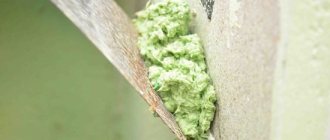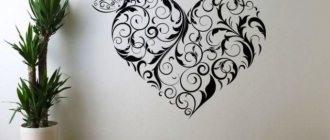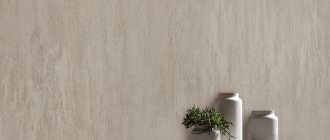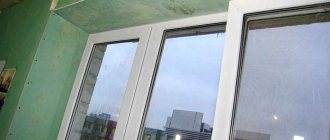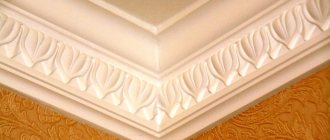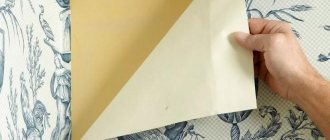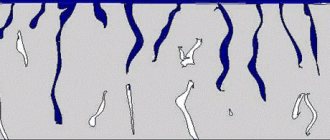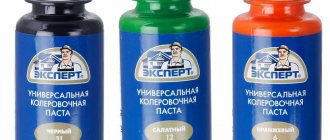The desire to make repairs yourself often appears suddenly. Sometimes it is so great that a novice builder is not afraid of either lack of experience or dirt. If you take on repairs with your own hands, then you need to value your work and do everything thoroughly. This article will tell you how to make a primer with your own hands.
It is necessary to prime working surfaces; without this, good repairs cannot be made. The material in this article will help you make sure that initial, deep priming is done simply and at low cost - you just need to follow the technology.
What is a primer?
Looking at the label in the store, seeing what the primer consists of, it becomes clear that it is a rather simple and easy-to-make substance. But it is indispensable in the construction business. The main task of the primer is the formation of an adhesive film on the surface being treated. Simply put, the mixture makes the surface more sticky for applied decorative materials.
Paint or putty adheres better to a primed surface because the primer fills its micropores and irregularities. Because of this, the area and force of adhesion of finishing materials to the surface increases greatly. Soil also performs other functions:
- Securing the foundation. The composition impregnates the loose prepared surface, preventing it from shedding and cracking after applying decorative coatings;
- Leveling the absorbency of the material. The prepared surface may have uneven thickness and uniformity of application. The mixture densely covers the entire surface, creates a uniform adhesive film over the entire surface;
- Protective and decorative function. Some types of primers are designed to protect the surface from exposure to weather conditions and solar radiation. Wood treated with a special primer reveals the grain structure and looks more beautiful.
Priming at home is really easy. How to replace the primer from an expensive hardware store will become clear below.
Carrying out finishing work without preliminary priming will lead to peeling of the applied material. All the work will have to be redone. Priming the work surface is a dust-free job that will help avoid the appearance of defects.
Tips for preparing primer
The use of certain substances can significantly improve the properties of home-prepared wall primers. For example, you can add crushed chalk or a small amount of resin to the building mixture. The composition obtained as a result of such manipulations is ideal for treating walls if they are covered with wallpaper.
A distinctive feature of PVA adhesive-based mixtures is that it is not absorbed into the base and does not make it possible to get rid of microcracks. Preparing a primer for walls at home is best done in a warm room, with the balcony and windows closed.
When mixing, it is necessary to simultaneously work with a stick or a special spatula so that the glue mixture can be completely dissolved in the liquid.
Types of primers
Construction mixtures differ in composition, purpose for different materials, and effect on the surface. Types of primers that are used in household repairs:
- Adhesive (concrete contact). Serves for better adhesion to applied materials. This primer is applied to walls prepared for painting or wallpapering.
- Deep penetration. Penetrating primers serve as a binding element between layers of leveling surfaces and strengthen the surface structure. This primer can be used for porous, loose, moisture-absorbing surfaces. They process putty, plaster, and drywall sheets. The deep penetration mixture, with its properties, ensures penetration into the porous structure and complete saturation of the material.
- Hydrophobic. When the surface needs to be protected from excessive exposure to moisture, it is coated with a hydrophobic mixture. The glue and resins that make up it prevent moisture from penetrating the material.
- Antiseptic. To protect a wall made of concrete or wood from the development of fungus, this composition will be simply irreplaceable. Along with the antifungal effect, this DIY wall primer provides good adhesion.
Primers are made from acrylic, chalk, cement, and various adhesives. Penetrating compounds are equally successful on bare concrete, putty, and plaster.
For painting
Here you can also use PVA glue. If everything is done correctly, a film is formed that is almost invisible from the outside. The main thing is to make sure that there is not too much glue when adding to the water. Otherwise, over time, such a surface deteriorates, parts separate from each other. Even if it's drywall.
Quick priming is a must even for those who have no experience in such work. It is recommended to follow these tips for better results:
- Before treatment, remove all dirt and old paint and varnish materials from the surface, if any.
- The mixture is poured into a special container; application involves the use of brushes or rollers. Then the convenience will be maximum. The first step is to process corners and hard-to-reach surfaces. The craft gives results immediately.
- Movements go from top to bottom.
- The second layer is applied only when the first one is completely dry. Then the clutch will become more reliable, and it will be easier to move on to other decorative work. The paint spreads without problems.
If there is not enough solution, prepare a new one. Only the container needs to be thoroughly cleaned, otherwise lumps will appear. Priming will not work effectively. When applying primer, it is recommended to avoid using sprayers; this will increase the risk of damage to the primer.
Any solutions prepared independently are stored for one day, no more. Otherwise, the original qualities are lost and painting is impossible.
The walls are covered with compounds after completion of all primary work. When repairing and restoring elevations, soils will be needed to increase the strength of the foundation. For preparation, you can use any of the recipes described above. Such materials are suitable for bricks that have begun to crumble. Copper sulfate can be easily purchased by visiting gardening and gardening stores. Hardware stores will help with the rest of the components; they can also be applied to the floor.
The need to visit stores does not always arise if the required type of primers is not available. It’s easier to gather available ingredients on hand to prepare the mixtures yourself. Their quality is no worse than other analogues. The only drawback is the shelf life, which is only a day. Without its observance, one may not think about the long-term preservation of the original qualities. Only the liquid form of the primer qualitatively fills all the pores on the surface, this should also be remembered.
In conclusion, we would like to note that there are quite a large number of options for replacing primer at home.
When choosing a replacement, focus on your needs, this will help you quickly solve the problem without difficulty and unnecessary hassle.
Homemade primer versus store-bought primer
What can replace the primer from the store? You can not only apply the primer to the wall yourself, but you can also make it. As a rule, the composition of primers differs slightly from different manufacturers. On the construction market you can buy the components listed on the label of the finished primer. From these components you can quickly make a material that will not be inferior in quality and properties to its store-bought counterpart.
Why make your own primer? It's cheaper. There is no need to overpay for packaging; the logo of a large company is on it. Instead of store-bought primer, you can use homemade primer, which is just as good. And someone may simply be pleased with the very act of making an important building mixture with their own hands.
If you make your own primer for walls, it will be suitable for treating mineral surfaces. But homemade mixtures for wood may not be suitable.
Can a homemade primer completely replace a store-bought one?
In individual situations - yes. It consists of the same components as the purchased one. And the characteristics are not inferior to the factory one. They differ only in cost. Ready-to-use products are sold at high prices. Its pricing takes into account markups for the brand and its promotion, packaging and transportation costs, and markups by intermediaries.
Each ingredient separately costs several times less. And it is always available for free sale. As a result, you can save on repair materials. The only drawback of homemade solutions is their fragility. They must be used within 24 hours.
It is not difficult to prepare a priming solution yourself. The main thing is to have patience, the accompanying materials and maintain proportions.
Making a primer
Components for homemade primers are available on any construction market. This composition is made quickly, it is immediately ready for use. The most important thing in the manufacturing process is the correct proportions. Each recipe written below will help you understand how to make your own primer.
Deep penetration composition
| PVA construction adhesive | 1 liter |
| Water | 8 liters |
| Cement or crushed chalk | 1 trowel |
You can make a deep penetration primer as follows:
- Pour glue into the container, add water to the glue and mix until smooth.
- Add cement or chalk powder to the suspension.
- Strain the resulting mixture through a gauze bandage.
PVA glue in the primer will protect the surface from moisture. It has excellent adhesive properties.
In the video: primer made from PVA glue.
Strengthening
| Wood glue (bone glue) | 500 ml. |
| Copper sulfate | 100 gr. |
| Water | 7 liters |
| Laundry soap 65% | 1 package |
The primer composition is made as follows:
- Bring water to a boil and add grated soap into it.
- Reduce heat and pour glue and copper sulfate into the pan.
- Keep the mixture on the fire for 30 minutes and stir.
- Strain the mixture through a gauze bandage.
The strengthening mixture will not only strengthen the structure of the concrete wall, but also protect against the appearance and growth of black mold.
Wood mixture
| Water | 1 liter |
| Alum | 250 gr. |
| Drying oil | 30 gr. |
| Dry paint glue | 200 gr. |
| Laundry soap | 1 package |
| Chalk | 2 kg. |
Preparation method:
- Pour alum into 3 liters of boiling water.
- Dilute the glue with the remaining water.
- Put the water with glue on the fire and add soap, drying oil and water with alum to it.
- Mix thoroughly, add chalk and mix again.
Penetrating primers have strengthening properties, while antifungal primers have adhesive properties. Therefore, if necessary, you can use the primer for tasks not intended for it.
Composition for deep penetration
This is the easiest composition to prepare - you need to mix PVA glue, water and cement in one container. Then you need to thoroughly mix all the ingredients until a homogeneous mass is formed, and then pass them through a sieve and cheesecloth.
This primer option is suitable for wallpaper and putty, and most importantly, it is cheaper than ready-made compounds from the store. In addition, its preparation does not take much time, which is a significant advantage.
This primer can be used immediately after mixing, but it must be taken into account that this is not a long-term product - its shelf life does not exceed a day.
Therefore, preparing such a primer for future use would not be the best solution.
Wood priming
The wood must be primed before it is painted or varnished. Primer for wood is made on an alkyd, acrylic, shellac, adhesive and drying oil base. Before applying varnish, the surface of the wood is cleaned of traces of dirt, grease or fuel oil. Sand the wood with fine sandpaper and then prime it. Follow these guidelines:
- After applying the first coat of primer, the wood needs to be sanded to smooth out the grain.
- Each layer of primer must dry for at least an hour, applying 2 or 3 layers in total.
- The acrylic composition is suitable for opening with water-dispersed varnish.
- The mixture with solvent is intended for subsequent coating with polyurethane-based varnish.
For resinous woods, a special aluminum primer is used. It penetrates deeper into the fibers.
Priming the walls
The composition should be applied to the walls after all initial work has been completed. Before applying the primer, it is recommended to moisten the walls with impregnation, which will remove fine dust and remaining dirt. Mold and remnants of old wallpaper must be removed from the surface.
The choice of primer for painting will depend on the composition of the paint. Acrylic composition is perfect for water-based paint. Important rules for carrying out work:
- The mixture should not contain lumps. It is better to remove large lumps immediately, while small ones need to be stirred with a mixer.
- For application, you can use a brush, roller or wide brush.
- The number of layers depends on the porosity and absorbency of the wall. The first layer can be applied with a penetrating primer.
- You can add wallpaper glue to the wallpaper primer.
- The composition should be applied with quick, wide movements.
- Allow the last layer to dry for 3-4 hours.
After applying the primer, the wall is ready for the final stage of repair. DIY wall primer done successfully. Putty and paint will no longer fall off in pieces from such a wall, and new wallpaper will not bubble. Such repairs can be considered successful and of high quality.
Making your own wall primer is very easy. The skills that were acquired during the repair will be useful more than once in the future. All the difficulties and troubles of repairs will be a thing of the past.
Methods for preparing high-quality primer (2 videos)
Different primer mixtures (21 photos)
The best option for wallpaper
The most effective method, which will significantly save time and provide a high-quality result, is mixing wallpaper glue with a regular primer. This composition ensures maximum penetration depth and firmly fixes the wallpaper.
The main advantage is that after applying the composition to the wall, you can immediately glue wallpaper onto it. Before applying the primer, you must thoroughly clean the wall of any debris. It is better to apply it with sweeping movements from bottom to top using a roller.
Alternative primer substitutes can be very useful because they can save you money without sacrificing quality. Each analogue has its own characteristics, which must be taken into account before making a choice.
The base can be ordinary wallpaper glue. This is a replacement for regular PVA for the composition. Protects and penetrates into the pores of the material as deeply as possible. There is no need to wait for drying; the wallpaper is immediately applied to the primer.
Adhesive-type compositions allow for independent preparation. The description of the components is as follows:
- 30 grams of drying oil. Plaster is not needed;
- 2 kg chalk;
- 250 aluminum alum;
- 200 grams of dry chalk for painting group;
- 200 grams of soap from the farm. This is the answer to the question of what primers are made of.
Cooking will not cause problems if you follow the instructions. Only at first glance the composition seems complex. Manufacturers, including well-known ones, use the same components for their developments. The cooking algorithm is as follows:
- Pour alum into 1 liter of water.
- Take a separate bowl and dilute glue in it.
- Make sure to keep the fire low. With constant stirring, add soap, alum and drying oil.
- Pour in chalk and mix well.
- Water is added when needed. Nobody is against this option.
